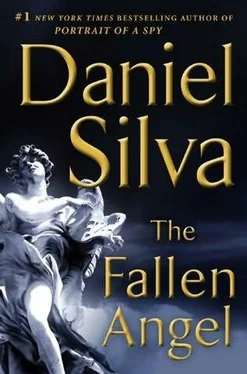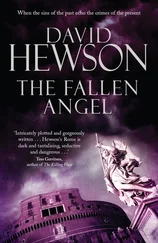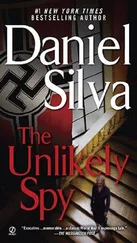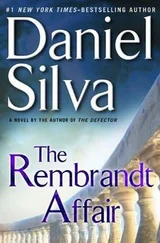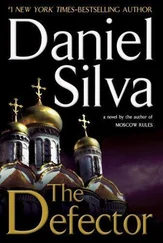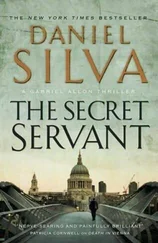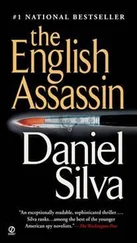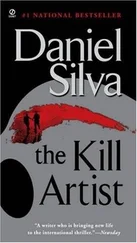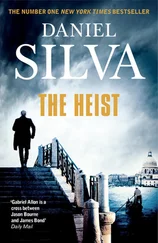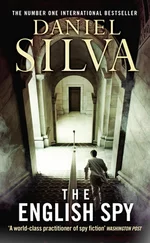“It’s almost hard to remember what this place was like before the Six-Day War,” Lavon said, gesturing toward the valley beneath the terrace. “My parents used to bring me here to see the barbed wire and the Jordanian gun emplacements along the ’forty-nine armistice line. Jews weren’t allowed to pray at the Western Wall or visit the cemetery on the Mount of Olives. Even Christians had to present proof of baptism before they were allowed to visit their holy sites. And now our friends in the West would like us to surrender sovereignty over the Wall to the Palestinians.” Lavon shook his head slowly. “For the sake of peace, of course.”
“It’s a pile of stones, Eli.”
“Those stones are drenched in the blood of your ancestors. And it’s because of those stones that we have a right to a homeland here. The Palestinians understand that, which explains why they like to pretend the Temple never existed.”
“Temple Denial,” said Gabriel.
Lavon nodded thoughtfully. “It’s a first cousin to Holocaust Denial, and it’s now just as widespread in the Arab and Islamic world. The calculus is quite simple. No Holocaust, no Temple . . .”
“No Jews in Palestine.”
“Precisely. But it’s not just talk. Using the religious authority of the Waqf, the Palestinians are systematically trying to erase any evidence that there was ever an actual temple on the Temple Mount. We’re fighting an archaeological war here in Jerusalem every day. One side is trying to preserve the past, and the other is trying to destroy it, primarily under the guise of construction projects like the Marwani Mosque.”
Capable of accommodating more than seven thousand worshipers, the mosque was located in the southeastern corner of the Temple Mount, in an ancient underground chamber known as Solomon’s Stables. The massive construction project had destabilized the sacred plateau and created a precarious bulge in the southern wall. Under a negotiated agreement between the Israeli government and the Waqf, an engineering firm from Jordan had made the repairs, leaving behind an unsightly patch of white that was clearly visible from across the city.
“Naturally,” Lavon continued, “a construction project the size of the Marwani Mosque displaced several tons of earth and debris. And what do you suppose the Waqf did with it?” Lavon quickly answered his own question. “They took it to the municipal dump or simply threw it over the walls into the Kidron Valley. I was part of the team that sifted through it. We found hundreds of artifacts dating from the First and Second Temples. They lacked proper archaeological context, of course, because they’d been ripped from their original settings.” He paused, then added, “Just like that shard of Greek pottery you’re walking around with.”
“A man like you can often tell a great deal from a single fragment.”
“Where did you get it?”
“From the home of a tomb raider in Cerveteri.”
“Roberto Falcone?”
Gabriel nodded.
“Please tell me you weren’t the one who pushed him into that vat of hydrochloric acid.”
“Acid isn’t my style, Eli. It’s far too slow.”
“And messy,” Lavon added with a nod. “I suppose the next thing you’re going to say is that there’s a link between Falcone and the woman who fell from the dome of the Basilica.”
“His name is Carlo Marchese,” Gabriel said. “Carlo controls the global trade in looted antiquities. He’s also in bed with Hezbollah. We’re going to put him out of business.”
“We?”
“I can’t do it alone, Eli. I need an archaeologist who can read a balance sheet and knows how to track dirty money. It would also be nice if he can handle himself on the street.”
“I thought you were retired.”
“So did I,” Gabriel said, “but for some reason I never seem to stay retired.”
Lavon looked out at the walls of the Old City.
“What are you thinking about, Eli?”
“It’s not a what. It’s a who.”
“Rivka?”
Lavon nodded.
“She’s waited for two thousand years,” Gabriel said. “She can wait a little longer.”
19
KING SAUL BOULEVARD, TEL AVIV
THERE WAS ANOTHER THING THAT had not changed in Gabriel’s absence: King Saul Boulevard. It was drab, featureless, and, best of all, anonymous. No emblem hung over its entrance, no brass lettering proclaimed the identity of its occupant. In fact, there was nothing at all to suggest it was the headquarters of one of the world’s most feared and respected intelligence services. A closer inspection of the structure, however, would have revealed the existence of a building within a building, one with its own power supply, its own water and sewer lines, and its own secure communications system. Employees carried two keys. One opened an unmarked door in the lobby; the other operated the lift. Those who committed the unpardonable sin of losing one or both of their keys were banished to the Judean Wilderness, never to be seen or heard from again.
Gabriel had come through the lobby just once, the day after his first encounter with Shamron. From that point forward, he had only entered the building “black,” through the underground garage. He did so again now, with Chiara and Eli Lavon at his side. They made their way down three flights of stairs, then followed an empty corridor to a doorway marked 456C. The room on the other side had once been a dumping ground for obsolete computers and worn-out furniture, often used by the night staff as a clandestine meeting place for romantic trysts. It was now known throughout King Saul Boulevard only as Gabriel’s Lair. The keyless cipher lock was set to the numeric version of his date of birth. According to one Office wit, it was the most closely guarded secret in all of Israel.
“What’s wrong?” Eli Lavon asked when Gabriel’s hand hesitated over the keypad.
“A senior moment.”
“You can’t remember your own birthday?”
“No,” said Gabriel, punching in the code. “I just can’t believe it was that long ago.”
He entered the room, switched on the overhead lights, and looked around at the walls. They were littered with the debris and the ghosts of operations past. All had resulted in innocent lives being saved, and all were soaked in blood, much of it Gabriel’s. He went to the chalkboard, the last chalkboard in the entire building, and saw faint traces of his own handwriting—the outlines of an operation known by the code name Masterpiece. It had resulted in the successful sabotage of Iran’s uranium enrichment facilities, and had purchased Israel and the West several years of critical time. Now it seemed that time was running out. The Iranians were once again on the doorstep of realizing their nuclear dreams. And it appeared they intended to punish anyone who tried to stand in their way, using Hezbollah, their eager proxy, as their instrument of vengeance.
“If the Office ever builds a museum,” Lavon said, “it won’t be complete unless it contains a replica of this room.”
“What would they call the exhibit?”
“The village of the damned.”
The response had come not from Lavon but from the tall, tweedy figure standing in the doorway, a thin file folder beneath his arm. Yossi Gavish was a senior officer from Research, the Office’s analytical division. Born in London and educated at All Souls, he still spoke Hebrew with a pronounced English accent and was incapable of working without a steady supply of Earl Grey tea and McVitie’s digestive biscuits.
“I can’t believe I’m back here again,” he said.
“Neither can I.” Gabriel nodded toward the file and asked, “What have you got there?”
“The sum total of what the Office currently knows about Carlo Marchese.” He dropped the file onto one of the worktables and looked around. “Does Uzi expect the four of us to take on Carlo and Hezbollah on our own?”
Читать дальше
Конец ознакомительного отрывка
Купить книгу
